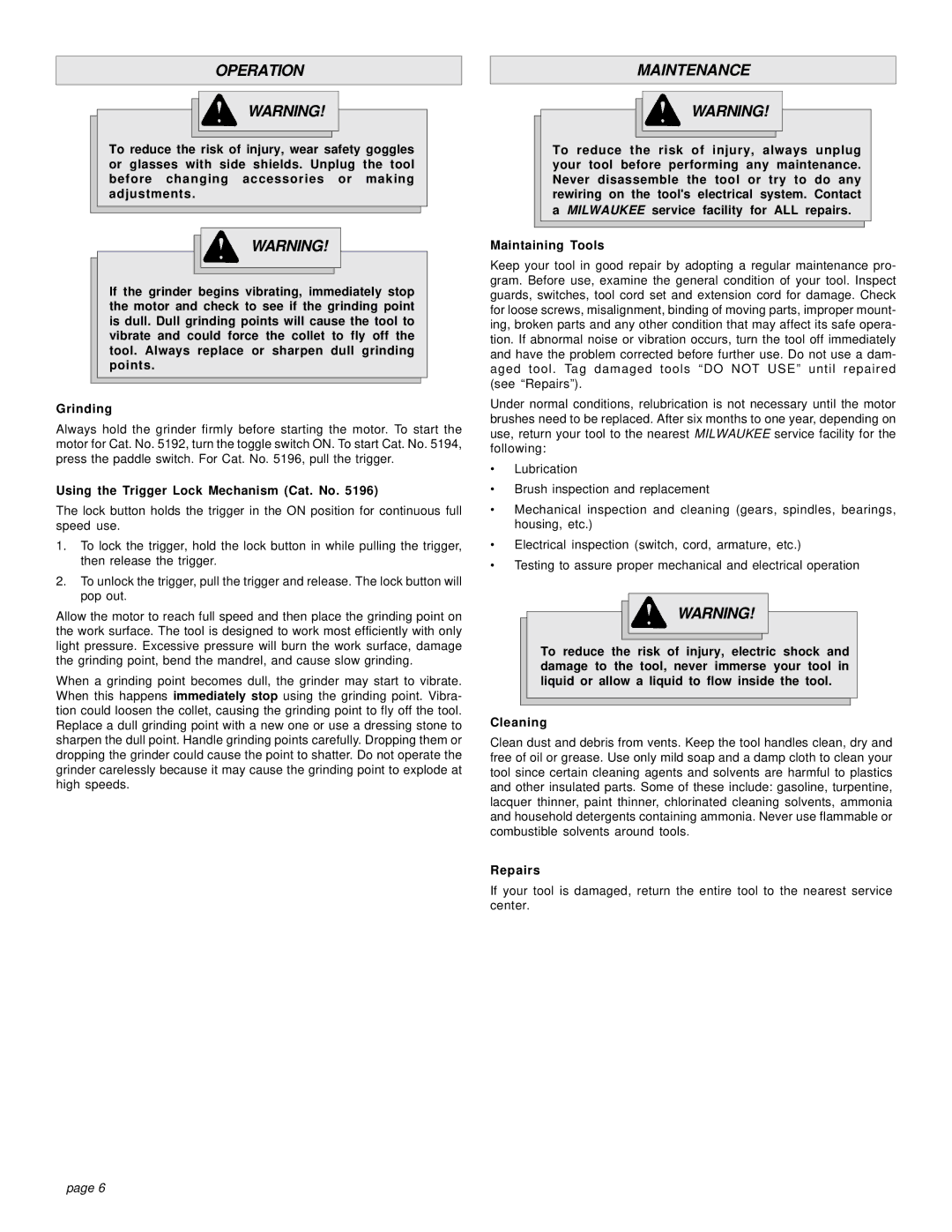
OPERATION
WARNING!
To reduce the risk of injury, wear safety goggles or glasses with side shields. Unplug the tool before changing accessories or making adjustments.
WARNING!
If the grinder begins vibrating, immediately stop the motor and check to see if the grinding point is dull. Dull grinding points will cause the tool to vibrate and could force the collet to fly off the tool. Always replace or sharpen dull grinding points.
Grinding
Always hold the grinder firmly before starting the motor. To start the motor for Cat. No. 5192, turn the toggle switch ON. To start Cat. No. 5194, press the paddle switch. For Cat. No. 5196, pull the trigger.
Using the Trigger Lock Mechanism (Cat. No. 5196)
The lock button holds the trigger in the ON position for continuous full speed use.
1.To lock the trigger, hold the lock button in while pulling the trigger, then release the trigger.
2.To unlock the trigger, pull the trigger and release. The lock button will pop out.
Allow the motor to reach full speed and then place the grinding point on the work surface. The tool is designed to work most efficiently with only light pressure. Excessive pressure will burn the work surface, damage the grinding point, bend the mandrel, and cause slow grinding.
When a grinding point becomes dull, the grinder may start to vibrate. When this happens immediately stop using the grinding point. Vibra- tion could loosen the collet, causing the grinding point to fly off the tool. Replace a dull grinding point with a new one or use a dressing stone to sharpen the dull point. Handle grinding points carefully. Dropping them or dropping the grinder could cause the point to shatter. Do not operate the grinder carelessly because it may cause the grinding point to explode at high speeds.
page 6
MAINTENANCE
WARNING!
To reduce the risk of injury, always unplug your tool before performing any maintenance. Never disassemble the tool or try to do any rewiring on the tool's electrical system. Contact a MILWAUKEE service facility for ALL repairs.
Maintaining Tools
Keep your tool in good repair by adopting a regular maintenance pro- gram. Before use, examine the general condition of your tool. Inspect guards, switches, tool cord set and extension cord for damage. Check for loose screws, misalignment, binding of moving parts, improper mount- ing, broken parts and any other condition that may affect its safe opera- tion. If abnormal noise or vibration occurs, turn the tool off immediately and have the problem corrected before further use. Do not use a dam- aged tool. Tag damaged tools “DO NOT USE” until repaired (see “Repairs”).
Under normal conditions, relubrication is not necessary until the motor brushes need to be replaced. After six months to one year, depending on use, return your tool to the nearest MILWAUKEE service facility for the following:
•Lubrication
•Brush inspection and replacement
•Mechanical inspection and cleaning (gears, spindles, bearings, housing, etc.)
•Electrical inspection (switch, cord, armature, etc.)
•Testing to assure proper mechanical and electrical operation
WARNING!
To reduce the risk of injury, electric shock and damage to the tool, never immerse your tool in liquid or allow a liquid to flow inside the tool.
Cleaning
Clean dust and debris from vents. Keep the tool handles clean, dry and free of oil or grease. Use only mild soap and a damp cloth to clean your tool since certain cleaning agents and solvents are harmful to plastics and other insulated parts. Some of these include: gasoline, turpentine, lacquer thinner, paint thinner, chlorinated cleaning solvents, ammonia and household detergents containing ammonia. Never use flammable or combustible solvents around tools.
Repairs
If your tool is damaged, return the entire tool to the nearest service center.
